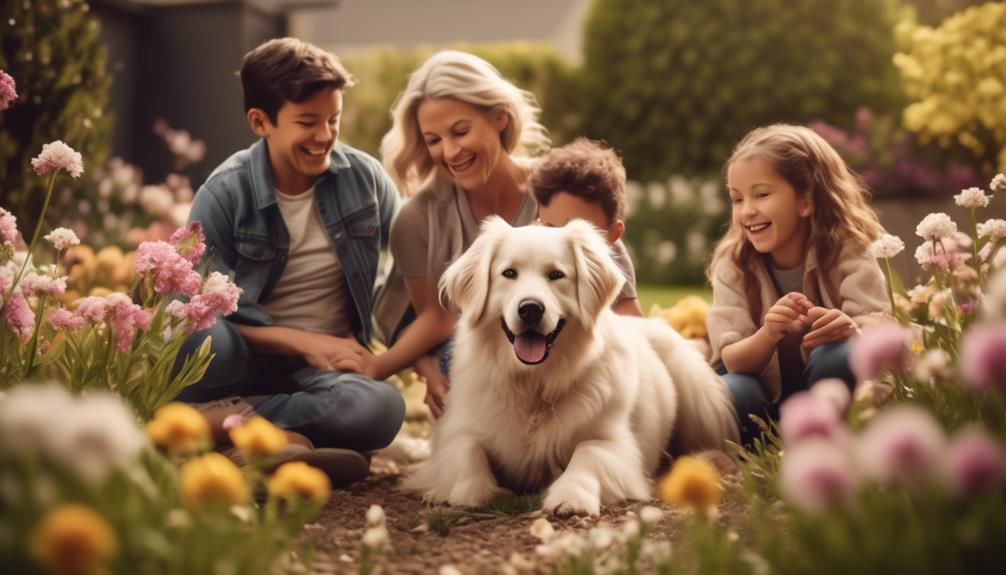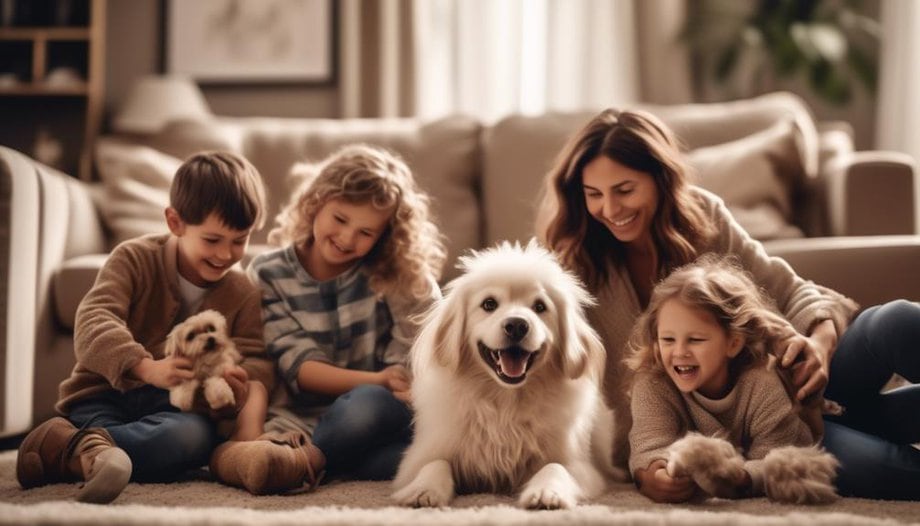How to Select a Dog Breed When You Have Kids With Allergies

Choosing a dog breed for kids with allergies can be a challenging task. However, with some careful consideration and research, you can find a breed that is suitable for your family. Here are some tips to help you in your search:
- Consult with an allergist: Before bringing a dog into your home, it is important to consult with an allergist to determine the specific allergies your child has. This will help you understand what triggers your child's allergies and what to look for in a dog breed.
- Look for hypoallergenic breeds: Hypoallergenic breeds are known to produce fewer allergens, making them a good choice for families with allergies. Some popular hypoallergenic breeds include poodles, bichon frises, and Portuguese water dogs.
- Consider the dog's coat: Dogs with hair instead of fur, such as poodles and some terrier breeds, tend to produce fewer allergens. Additionally, dogs with shorter coats may shed less dander, reducing the risk of triggering allergies.
- Spend time with the dog: It is important to spend time with the dog you are considering before bringing them home. This will allow you to see if your child has any allergic reactions to the specific dog breed.
- Regular grooming: Regular grooming can help reduce allergens in your home. Brushing your dog's coat regularly and bathing them frequently can help remove dander and allergens.
- Consider a trial period: Consider having a trial period with the dog before making a final decision. This will give your child the chance to interact with the dog and see if their allergies are manageable.
By following these tips and taking the necessary precautions, you can find a dog breed that is a good fit for your family, even if your child has allergies. Remember that every child's allergies are different, so it is important to consult with a healthcare professional before making a decision.
Key Takeaways
- Consultation with an allergist and veterinarian is essential to determine specific allergies, triggers, and recommendations for selecting a hypoallergenic dog breed.
- Consider breeds like poodles, bichon frises, and Portuguese water dogs that are known to produce fewer allergens and have hair instead of fur.
- Spend time with the dog before bringing them home to observe any allergic reactions in the child and assess compatibility and comfort level.
- Create dog-free areas in the house, invest in hypoallergenic products, implement a regular cleaning routine, and maintain the dog's hygiene through grooming and regular bathing to manage allergens in the home.
Understand Your Children's Allergies
Understanding your children's allergies is essential when selecting a dog breed that will be compatible with their needs. Some children are allergic to dog hair, while others are allergic to dander or saliva. It's crucial to identify the specific allergen that triggers your child's symptoms in order to choose a hypoallergenic dog breed. These breeds are known for producing fewer allergenic substances and shedding less, making them suitable for people with dog allergies.
One hypoallergenic breed to consider is the Bichon Frise. These small, white dogs have a curly coat that doesn't shed much, reducing the amount of hair and dander that can cause allergies. Similarly, the Coton de Tulear is another hypoallergenic breed with a cotton-like coat that doesn't shed excessively. The American Hairless Terrier is an excellent choice for those allergic to dog hair, as they've little to no hair, decreasing the allergen exposure.
Another option is the Portuguese Water Dog, which has a hypoallergenic coat that doesn't shed. These dogs are known for their friendly and energetic nature, making them great companions for children with allergies.
Understanding your children's allergies and the specific triggers they've is crucial when selecting a dog breed. By choosing a hypoallergenic breed such as the Bichon Frise, Coton de Tulear, American Hairless Terrier, or Portuguese Water Dog, you can ensure that your child can enjoy the company of a dog without experiencing allergic reactions.
Research Hypoallergenic Dog Breeds

When researching hypoallergenic dog breeds, it's important to consider several factors to ensure the right fit for your family's needs. Understanding that dog allergies are often caused by dander or saliva, not the hair itself, is essential. Here are some key points to consider:
- Look for breeds that produce less dander: Breeds like Schnauzers, Maltese, Labradoodles, Bichon Frises, Portuguese Water Dogs, or Xoloitzcuintlis are known to produce less dander and are suitable for families with allergies.
- Avoid breeds with excessive saliva or dry skin: Bulldogs, Saint Bernards, Boston Terriers, German Shepherds, and Pekingese are breeds that may not be suitable for people with allergies due to excessive saliva, mucus, dry skin, or difficulty in house-training.
- Regular grooming is a must: Hypoallergenic breeds require regular grooming and maintenance to minimize allergen exposure. This includes brushing their coat, bathing, and clipping their hair. Finding a reputable breeder who can guide you on grooming practices is essential.
Consider Size and Activity Level

To further narrow down your search for a hypoallergenic dog breed that is suitable for your family's needs, it is important to consider the size and activity level of the potential dog. Taking these factors into account will help you choose a dog breed that is not only relevant to your kids' allergies, but also fits well within your living space and lifestyle.
Consider the size of the dog breed. Smaller breeds are often more suitable for indoor living and can adapt well to smaller spaces. They are also generally easier to handle for children, reducing the risk of accidents. On the other hand, larger breeds may require more space and exercise.
Activity level is another important aspect to consider. Some breeds have lower energy levels and are content with short walks and indoor play, while others have higher energy levels and require more outdoor exercise. It is essential to match the activity level of the dog with your family's dynamics.
To help you visualize the different sizes and activity levels of dog breeds, here is a table that categorizes them:
| Size | Low Activity Level | Moderate Activity Level | High Activity Level |
|---|---|---|---|
| Small | Maltese, Shih Tzu, Cavalier King Charles Spaniel | French Bulldog, Boston Terrier, Pug | Jack Russell Terrier, Border Collie, Labrador Retriever |
| Medium | Bichon Frise, Cocker Spaniel, Beagle | Bull Terrier, Australian Shepherd, Boxer | Siberian Husky, Vizsla, Weimaraner |
| Large | Standard Poodle, Golden Retriever, Bernese Mountain Dog | Doberman Pinscher, German Shepherd, Rottweiler | Dalmatian, Irish Setter, Great Dane |
Assess Grooming Requirements

Assessing the grooming requirements of different dog breeds is crucial in finding a suitable match for your family's needs and allergies.
When it comes to selecting a dog breed for kids with allergies, considering the amount of hair a dog breed has is essential. Breeds that shed less hair are a great option as they tend to produce fewer allergens.
Hypoallergenic dogs, such as Portuguese Water Dogs and Xoloitzcuintlis, are popular choices for families with allergy concerns. These breeds have hair instead of fur, which means they shed less dander, the main culprit behind allergic reactions.
Regular grooming, including bathing and brushing, can help minimize allergens such as dander and saliva on the dog's coat. Professional grooming services can be particularly beneficial for allergy-sensitive individuals as they can help minimize allergen exposure during bathing and grooming.
By regularly grooming your dog, you can effectively manage allergens and reduce the risk of allergy symptoms for your kids.
When getting a dog, be sure to assess the grooming requirements of different breeds to find the best fit for your family's needs and allergies.
Meet the Dog Breed in Person

When selecting a dog breed for kids with allergies, it's essential to personally meet the dog breed to observe their interaction with your child and assess any allergic reactions firsthand. This step is crucial because it allows you to see how your child responds to the dog and determine if they've any allergic reactions.
By visiting the breeder or shelter, you can spend time interacting with the dog and observe their temperament around your child. This will help you gauge whether the dog is a good fit for your family's allergies. Additionally, it's important to consider the shedding and grooming needs of different breeds and see if they align with your family's needs.
By meeting the dog breed in person, you can also ask the breeder or shelter staff about specific care and characteristics of the breed to ensure it's a perfect choice for your family. Remember, finding a hypoallergenic dog doesn't guarantee that no one will have an allergic reaction, but it's less likely to occur.
Meeting the dog breed in person allows you to make an informed decision and find a dog that will be a great fit for your family, especially for people with allergies.
Consult With a Veterinarian

Consulting with a veterinarian is an essential step in selecting a dog breed for kids with allergies, as they can provide professional advice and guidance on managing pet allergies. Veterinarians have the knowledge and expertise to assess potential dog breeds and recommend suitable options based on individual family circumstances and the severity of allergies.
Here are some reasons why consulting with a veterinarian is crucial:
- Allergy tests: Veterinarians can conduct allergy tests to determine the specific triggers for allergic reactions in children. This information is vital in identifying dog breeds that are less likely to cause allergies and helps in making an informed decision.
- Grooming and maintenance: Veterinarians can provide comprehensive information on a dog breed's grooming and maintenance needs. Regularly grooming the dog, including brushing its coat, can help minimize allergen exposure by removing dander and other allergens from the fur.
- Hypoallergenic breeds: Veterinarians can recommend suitable hypoallergenic dog breeds that produce fewer allergens. These breeds often have hair instead of fur, which reduces shedding and dander production, making them less likely to cause allergic reactions.
Prepare Your Home for a New Dog

To ensure a safe and allergen-free environment for your new dog, it's important to take proactive steps in preparing your home. Start by creating designated dog-free areas in your home to minimize allergen exposure. This will provide a safe space for family members with allergies to retreat to when needed.
Investing in hypoallergenic products like bedding and air purifiers can also help reduce allergens in the house. These products are designed to trap and remove pet hair, dander, and other allergens from the air and surfaces.
Implementing a regular cleaning routine is crucial to keeping your home free of excess pet dander and hair. Vacuuming regularly, using a vacuum cleaner with a HEPA filter, and sweeping hard floors can help remove allergens from your home. Consider using washable or easily cleanable surfaces, such as hardwood or tile flooring, to reduce allergen build-up.
It is also important to keep your dog's living space clean and well-ventilated. Regularly grooming your dog can help minimize shedding and the spread of allergens. Brushing your dog's coat and bathing them regularly can help remove loose hair and dander.
Additionally, ensure your dog's living space is well-ventilated to minimize allergen accumulation. Opening windows or using fans can help improve air circulation and reduce allergens in the air.
Frequently Asked Questions
What Is the Best Dog for a Child With Allergies?
The best dog for a child with allergies is a hypoallergenic breed. These allergy-friendly dogs have low dander production and don't shed much, reducing the risk of triggering allergy symptoms.
Can a Child With Dog Allergies Live With a Dog?
Yes, a child with dog allergies can live with a dog. Allergy-friendly dog breeds, proper grooming, and minimizing allergens in the home can help. Other alternative pets and allergy management options should also be considered.
What Is the Best Pet for a Child With Allergies?
There are several allergy-friendly pets available as alternatives to dogs, such as hypoallergenic cats or non-shedding dog breeds. Managing allergies involves allergy testing, cleaning tips, and allergy medications for relief. It is important to recognize and manage allergic reactions in children and take steps to minimize pet dander in the home.
Do I Have to Get Rid of My Dog if My Child Is Allergic?
If a child is allergic to a dog, there are ways to manage allergies while keeping the dog. Regular grooming, allergy-friendly breeds, and creating an allergen-free environment can help reduce symptoms and maintain a happy family.









